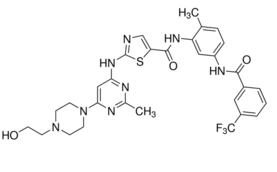|
UM-164, a dasatinib analogue, is a potent and dual inhibitor of the Src/p38 kinase with potential anticancer activity for Triple-Negative Breast Cancer (TNBC). It is a promising lead compound for developing the first targeted therapeutic strategy against TNBC. c-Src has been shown to play a pivotal role in breast cancer progression, metastasis, and angiogenesis. In the clinic, however, the limited efficacy and high toxicity of existing c-Src inhibitors have tempered the enthusiasm for targeting c-Src. UM-164 binds the inactive kinase conformation of c-Src. Kinome-wide profiling of UM-164 identified that Src and p38 kinase families were potently inhibited by UM-164. UM-164 alters the cell localization of c-Src in TNBC cells. In xenograft models of TNBC, UM-164 resulted in a significant decrease of tumor growth compared with controls, with limited in vivo toxicity.
|
Physicochemical Properties
| Molecular Formula |
C30H31F3N8O3S
|
| Molecular Weight |
640.69
|
| Exact Mass |
640.22
|
| Elemental Analysis |
C, 56.24; H, 4.88; F, 8.90; N, 17.49; O, 7.49; S, 5.00
|
| CAS # |
903564-48-7
|
| Related CAS # |
|
| PubChem CID |
11714353
|
| Appearance |
White to off-white solid powder
|
| LogP |
4.7
|
| Hydrogen Bond Donor Count |
4
|
| Hydrogen Bond Acceptor Count |
13
|
| Rotatable Bond Count |
9
|
| Heavy Atom Count |
45
|
| Complexity |
991
|
| Defined Atom Stereocenter Count |
0
|
| InChi Key |
ANEBQUSWQAQFQB-UHFFFAOYSA-N
|
| InChi Code |
InChI=1S/C30H31F3N8O3S/c1-18-6-7-22(37-27(43)20-4-3-5-21(14-20)30(31,32)33)15-23(18)38-28(44)24-17-34-29(45-24)39-25-16-26(36-19(2)35-25)41-10-8-40(9-11-41)12-13-42/h3-7,14-17,42H,8-13H2,1-2H3,(H,37,43)(H,38,44)(H,34,35,36,39)
|
| Chemical Name |
| 2-[[6-[4-(2-Hydroxyethyl)-1-piperazinyl]-2-methyl-4-pyrimidinyl]amino]-N-[2-methyl-5-[[3-(trifluoromethyl)benzoyl]amino]phenyl]-5-thiazolecarboxamide |
|
| Synonyms |
|
| HS Tariff Code |
2934.99.03.00
|
| Storage |
Powder-20°C 3 years
4°C 2 years
In solvent -80°C 6 months
-20°C 1 month
|
| Shipping Condition |
Room temperature (This product is stable at ambient temperature for a few days during ordinary shipping and time spent in Customs)
|
|
Biological Activity
| ln Vitro |
UM-164 has demonstrated remarkable potency as a c-Src inhibitor in biochemical studies, with a binding constant that is similar to that of dasatinib (UM-164 Kd=2.7 nM, Dasatinib Kd=0.7 nM). In order to verify UM-164's ability to prevent c-Src from activating in vitro, the impact of UM-164 on c-Src autophosphorylation is investigated in two TNBC cell lines (MDA-MB 231 and SUM 149). It is shown that the inhibition of c-Src autophosphorylation is concentration- and time-dependent. Complete c-Src autophosphorylation abrogation is seen at 50 nM after 120 minutes, indicating that UM-164 is a strong c-Src inhibitor in vitro. UM-164 treatment of MDA-MB 231 and SUM 149 resulted in a 25% and 28% rise in the proportion of G0-G1 cells, respectively, and a 16% and 19% decrease in the fraction of S cells, according to flow cytometry experiments[1].
|
| ln Vivo |
MDA-MB 231 and SUM 149 cell lines are implanted into NCr/nude mice for the purpose of performing xenograft studies. The mice are randomized into control and treatment groups as soon as the tumors are evident. Every other day, five mice from each group receive an intraperitoneal injection of either a medication (10 and 20 mg/kg in both xenograft experiments; a 15 mg/kg dose is added to the SUM 149 xenograft trials) or a vehicle. Even after 52 days of therapy, the treated animals show no appreciable weight loss or obvious abnormalities at the chosen dosages of UM-164. On the other hand, compared to the vehicle-treated group, tumor development is considerably suppressed in both the 10 mg/kg and 20 mg/kg treatment groups (P<0.026 and P<0.004, respectively)[1].
|
| Animal Protocol |
| Dissolved in a mixture of DMSO/propylene glycol (1:9); 10 mg/kg, 15 mg/kg, or 20 mg/kg; i.p. injection | | NCr/nude mice, 6 weeks of age | |
|
| References |
[1]. UM-164: A Potent c-Src/p38 Kinase Inhibitor with In Vivo Activity against Triple-Negative Breast Cancer. Clin Cancer Res. 2016 Oct 15;22(20):5087-5096.
|
|
Solubility Data
| Solubility (In Vitro) |
|
| Solubility (In Vivo) |
Solubility in Formulation 1: 5 mg/mL (7.80 mM) in 50% PEG300 +50% Saline (add these co-solvents sequentially from left to right, and one by one), suspension solution; with sonication.
Preparation of saline: Dissolve 0.9 g of sodium chloride in 100 mL ddH₂ O to obtain a clear solution.
(Please use freshly prepared in vivo formulations for optimal results.)
|
| Preparing Stock Solutions |
|
1 mg |
5 mg |
10 mg |
| 1 mM |
1.5608 mL |
7.8041 mL |
15.6082 mL |
| 5 mM |
0.3122 mL |
1.5608 mL |
3.1216 mL |
| 10 mM |
0.1561 mL |
0.7804 mL |
1.5608 mL |
*Note: Please select an appropriate solvent for the preparation of stock solution based on your experiment needs. For most products, DMSO can be used for preparing stock solutions (e.g. 5 mM, 10 mM, or 20 mM concentration); some products with high aqueous solubility may be dissolved in water directly. Solubility information is available at the above Solubility Data section. Once the stock solution is prepared, aliquot it to routine usage volumes and store at -20°C or -80°C. Avoid repeated freeze and thaw cycles. |
